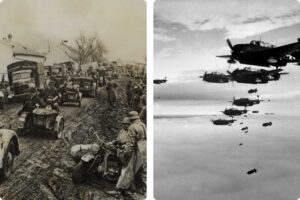On 14 May 1940, one of the most violent events in Dutch history unfolded: the Rotterdam bombardment. This devastating aerial attack by the German Luftwaffe reduced the city to rubble, claiming hundreds of lives, leaving thousands homeless, and marking the start of the German occupation of the Netherlands. However, this tragic moment also became the catalyst for Rotterdam’s transformation into the modern city we know today.
Why Rotterdam became a target
In the early days of May 1940, during the German invasion of Nederland, Rotterdam was identified as a key strategic target. Its location on the river Maas and its role as a vital port made the city crucial for transport and logistics. German forces sought to capture Rotterdam to force a Dutch surrender. When negotiations stalled, the German Luftwaffe decided to initiate a bombing campaign to compel capitulation.
The devastation of 14 May 1940
On the afternoon of 14 May 1940, German bombers appeared over Rotterdam. In just 15 minutes, they unleashed more than 97 tonnes of explosives on the city’s center. The destruction was immediate and overwhelming: an area of over 2.6 square kilometers was obliterated. Historic buildings, homes, and churches were reduced to ashes, and fires ignited by the bombs caused further devastation.
The human toll was immense. Approximately 900 people lost their lives, thousands were injured, and 85,000 residents were left homeless. The psychological and strategic impact of the Rotterdam bombardment rippled across the country. Fearing similar destruction in other cities like Utrecht, the Dutch government decided to surrender the following day, on 15 May 1940.
Life after the bombardment
For the people of Rotterdam, the bombing meant more than the loss of their homes and loved ones—it signified the destruction of the city they called home. The historic heart of Rotterdam was gone, and the city faced a choice: rebuild as it once was or start anew.
After the war, Rotterdam chose renewal. Guided by urban planners and architects, the city embraced a modern, functional design. Wide streets, new infrastructure, and innovative architecture became the hallmarks of Rotterdam’s rebirth. Today, iconic landmarks like the Market Hall, Cube Houses, and the Erasmus Bridge symbolize this forward-thinking vision.
Remembering and learning
Despite its modern appearance, Rotterdam remains deeply connected to its history. Every year, on 14 May, the city commemorates the victims of the bombardment with silent marches and ceremonies. The artwork ‘De Brandgrens’ (The Fire Boundary) marks the area destroyed during the bombing, serving as a poignant reminder of the city’s tragic past.
From ruins to a modern metropolis
Rotterdam, once reduced to ashes, has risen to become a vibrant and innovative metropolis. By embracing progress and innovation, the city has transformed its darkest moment into a testament to resilience and creativity.
Curious to explore Rotterdam’s impressive modern architecture and history? Book the SmartWalk Rotterdam, a self-guided tour that allows you to discover the city’s most stunning sights at your own pace.
Looking for more inspiration? Check out our blogs for the best practical tips for your stay, must-see attractions, and top restaurants in Rotterdam.
Experience how this city has turned devastation into a modern masterpiece!






